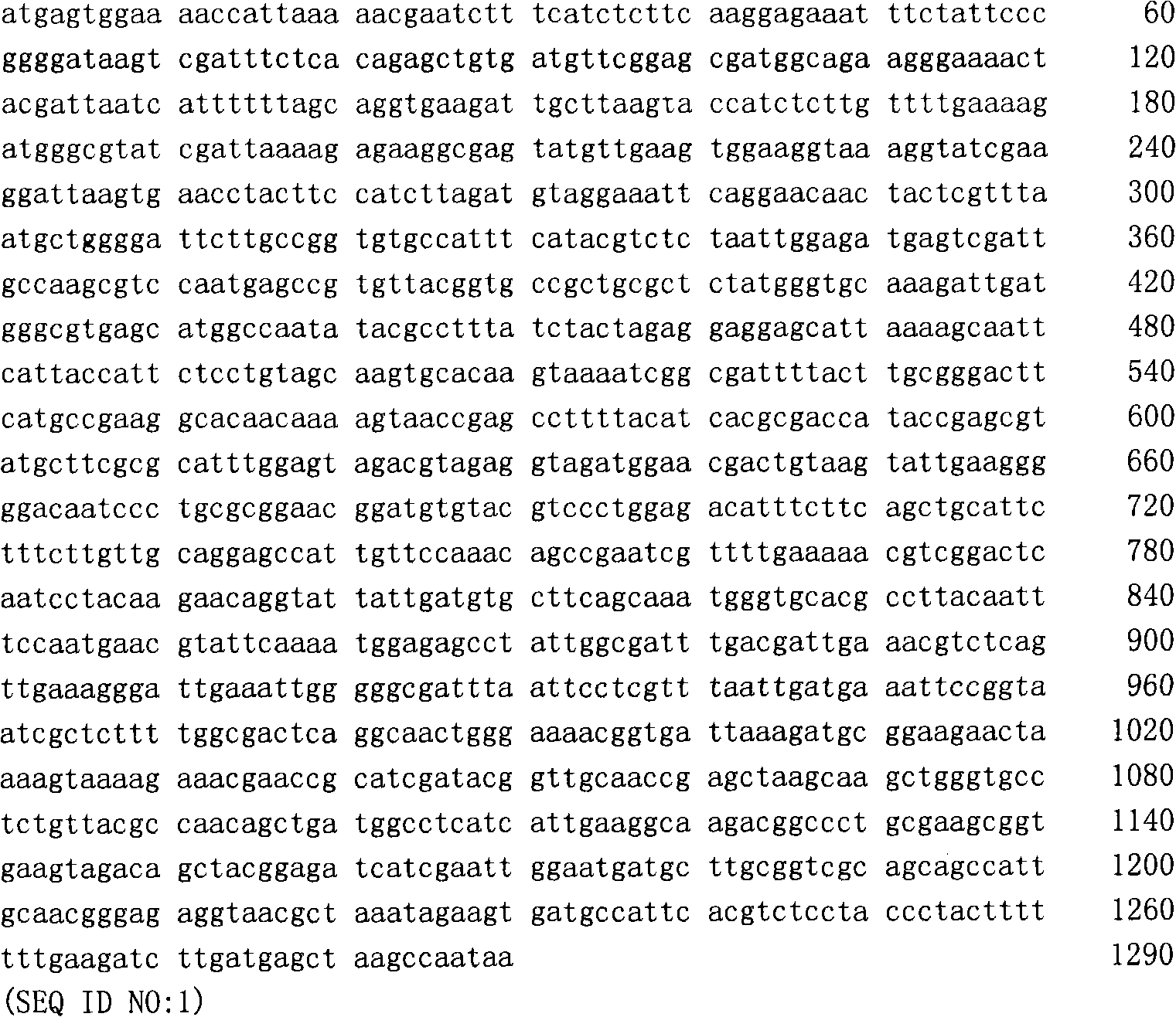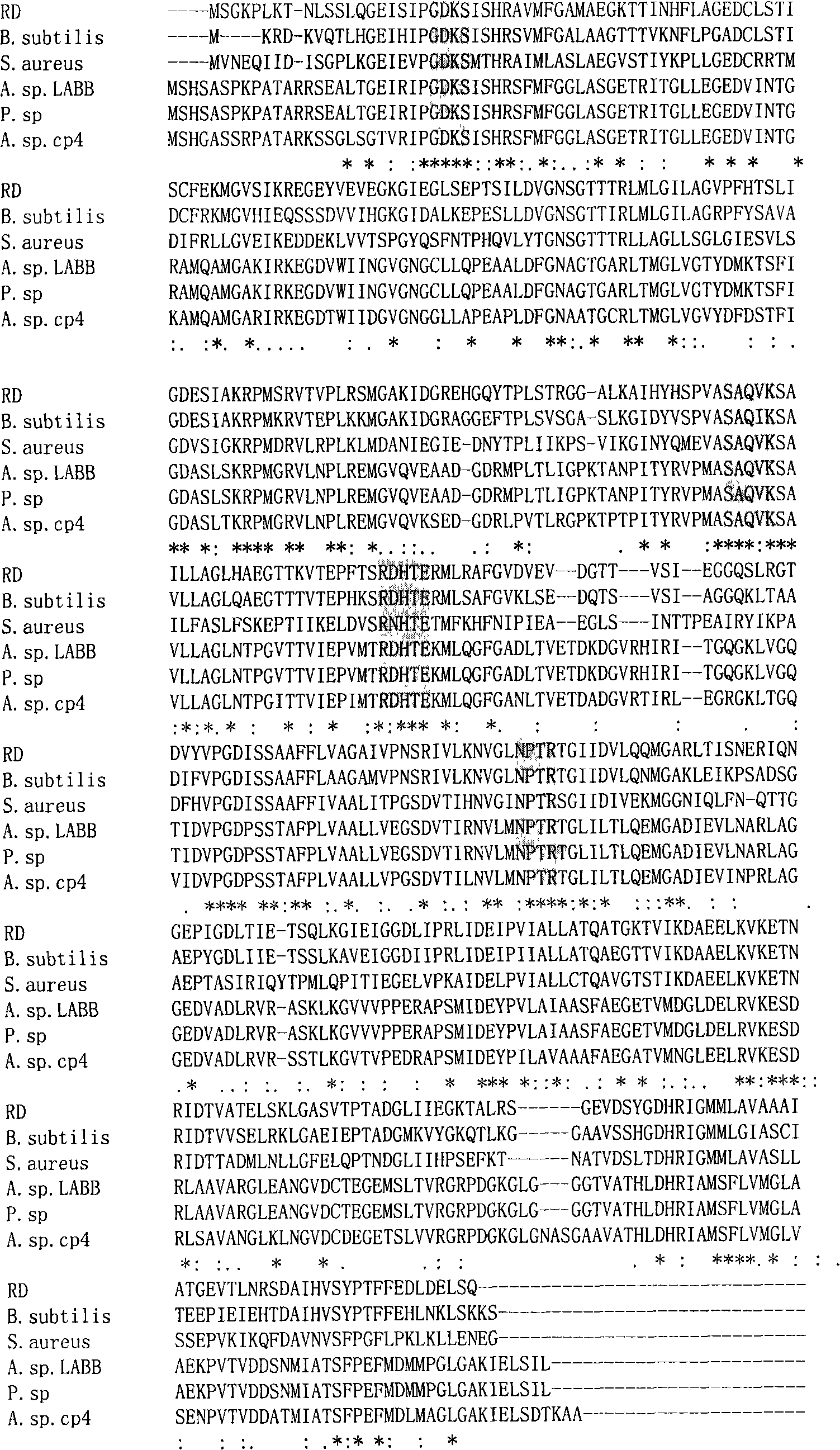EPSP synthase of high resistant glyphosate and coding sequence thereof
A technology of EPSP synthase and coding sequence, applied to the use and preparation of polynucleotides and polypeptides, 5-enolpyruvylshikimate-3-phosphate synthase gene and its protein product, with glyphosate resistance In the field of enzymes, it can solve the problems of no glyphosate-resistant gene patents, and no reports of glyphosate-resistant crops entering the commercialization stage.
- Summary
- Abstract
- Description
- Claims
- Application Information
AI Technical Summary
Problems solved by technology
Method used
Image
Examples
Embodiment 1
[0081] Example 1: Cloning of DNA fragments highly resistant to glyphosate
[0082] 1. Collection of soil samples in extremely glyphosate polluted environment
[0083] In the natural environment, especially in the soil of areas where glyphosate and other herbicides have been used for a long time, there are a wide variety of bacterial strains that can tolerate glyphosate or other herbicides. Samples were collected from soil that had been polluted by about 50% of glyphosate for more than ten years (an open distribution point of a glyphosate production plant of a chemical company in Hebei).
[0084] 2. Isolation of community-level total DNA from glyphosate-contaminated soil samples using a culture-free method
[0085] Weigh 2 g of glyphosate-contaminated soil samples, add 0.6 g of fine glass beads (d<0.11 mm), and shake twice at 4000 rpm. Add 300μl 2% SDS + 12% phenol Tris buffer (pH8.0) solution on ice for 1 hour, add an equal amount of phenol Tris buffer, pH8.0 (about 700ml), ...
Embodiment 2
[0096] Example 2: Sequence analysis of highly glyphosate-resistant DNA fragments and functional verification of EPSP synthetase
[0097] 1. Sequence analysis of DNA fragments highly resistant to glyphosate
[0098] The full nucleotide sequence of the highly glyphosate-resistant DNA fragment subcloned in Example 1 was determined. The analysis results showed that the inserted fragment was 2482bp in size, which contained a 1290bp reading frame, and its sequence was as shown in SEQ ID NO: 1 and figure 1 As shown, the full length of the polynucleotide sequence it contains is 1290 bases, and its open reading frame is located at positions 1-1287, encoding a full length 429 amino acid EPSP synthetase (SEQ ID NO: 2 and figure 2 ).
[0099]Comparing the subcloned highly glyphosate-resistant coding sequence with the reported EPSP synthase coding gene (aroA), there is almost no homology at the nucleotide level.
[0100] The amino acid sequence homology analysis results show that the E...
Embodiment 3
[0104] Embodiment 3: Artificial synthesis of highly glyphosate-resistant EPSP synthase gene
[0105] According to the completed nucleotide sequence containing the 1290bp coding region, first divide 8 segments into 150-200bp single-stranded oligonucleotide fragments with cohesive ends according to the positive and secondary strand sequences respectively. Anneal the 8 complementary single-stranded oligonucleotide fragments in one-to-one correspondence between the positive strand and the auxiliary strand respectively to form 8 double-stranded oligonucleotide fragments with sticky ends. The mixed double-stranded oligonucleotide fragments are catalyzed by T4 DNA ligase and assembled into a complete EPSP synthase gene. The synthetic DNA fragment contains the 1-1287 nucleotide sequence in SEQ ID NO: 1, and the upstream and downstream ends of the synthetic gene contain NdeI and HindIII sites.
[0106] The artificially synthesized 5' and 3' end restriction sites are NdeI and HindIII s...
PUM
 Login to View More
Login to View More Abstract
Description
Claims
Application Information
 Login to View More
Login to View More - R&D
- Intellectual Property
- Life Sciences
- Materials
- Tech Scout
- Unparalleled Data Quality
- Higher Quality Content
- 60% Fewer Hallucinations
Browse by: Latest US Patents, China's latest patents, Technical Efficacy Thesaurus, Application Domain, Technology Topic, Popular Technical Reports.
© 2025 PatSnap. All rights reserved.Legal|Privacy policy|Modern Slavery Act Transparency Statement|Sitemap|About US| Contact US: help@patsnap.com



